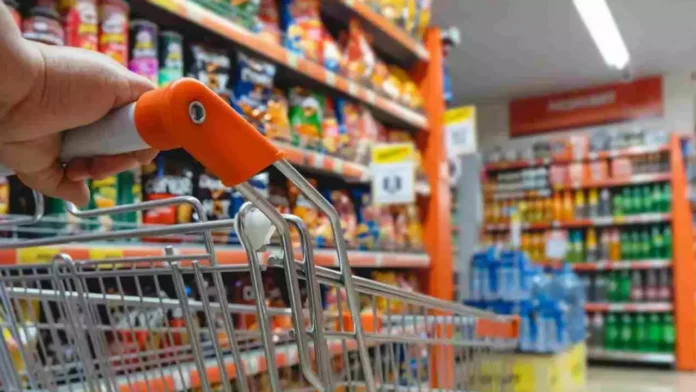Retail sales in India experienced a sudden halt in 2023, with the growth rate in sectors like apparel, footwear, beauty, and quick-service restaurants (QSR) dropping by half to a mere 9% following two years of pandemic-induced surges. This downturn underscores a subdued consumer sentiment, although expenditure on big-ticket items such as automobiles and electronics remained steady, buoyed by accessible loans.
Analysts and industry executives anticipate a prolonged market slump, with a recovery expected only after two to three quarters.
The Retailers Association of India (RAI) reported that within the apparel and footwear sectors, the value category catering to budget-conscious consumers suffered the most severe impact.
Last year, the organised retail sector experienced a same-store sales growth (SSG) of 2-3%, indicating a slowdown in demand for clothing, footwear, cosmetics, and fast food, despite three-fourths of its annual sales growth being attributed to network expansion.
Continue Exploring: Indian retail giants scale back store expansion amidst slowing consumption trends
Furthermore, a report by RAI indicates that the traditionally bustling October to December period, characterized by festivals, witnessed only a modest sales growth of 6%, with like-to-like sales declining compared to 2022.
The report conducted a survey of the top 100 retailers across various segments of modern retail in the country. Same-store sales growth (SSG) serves as a gauge of customer demand and assesses revenue generated from stores operational for at least a year.
“Like-for-like growth has been quite muted throughout the year. Most of the brands have expanded to new geographies and whatever the growth we are seeing is due to that. We were expecting things to recover after January but the way things are looking, the slowdown seems slightly prolonged,” said Devarajan Iyer, chief executive of department store chain Lifestyle International.
In 2022, the majority of apparel and lifestyle retailers hiked prices across various categories, particularly following a spike in cotton prices attributed to increased shipment costs and depreciation of the rupee.
However, last year witnessed companies either reducing prices or providing significant discounts to liquidate unsold inventory following price hikes in the preceding year.
Continue Exploring: Flash sales take center stage as apparel retailers struggle with year-end demand slump
“We have seen slowdown across consumer segments but were expecting a retail recovery during October-December quarter which has not happened so far. Unless interest rates are lowered, companies, especially tech firms, give decent salary hikes and there are no further job losses, we do not see a recovery for another 2-3 quarters,” said Abneesh Roy, executive director at Nuvama Institutional Equities.
During the pandemic, there was a surge in sales of athleisure wear, followed by apparel and lifestyle products, which defied the overall sluggish trend due to pent-up demand and consumers upgrading their wardrobes after the reopening of offices. However, this momentum has now stabilized.
“Revenge shopping that we saw during the pandemic was never sustainable. While people are buying higher priced products including cars and electronics with finance options, the increasing EMI every month is forcing them to cut back on lifestyle products like clothing and accessories,” said Kumar Rajagopalan, chief executive officer of RAI.
In 2023, the fashion retail segment grappled with a slowdown in demand due to inflationary pressures. According to RAI’s report, the value category experienced a greater impact compared to premium products and has not yet reached its pre-pandemic level of average sales per square feet.
In terms of segments, apparel and clothing experienced the slowest growth rate at 8%, whereas QSR expanded by 13% in 2023. Sales of furniture, sporting goods, and jewellery saw a 12% rise, while beauty, electronics, and food and grocery each recorded an 11% growth.
Meanwhile, during a recent investors’ call, Shoppers Stop reported a post-Christmas recovery in its retail chain. However, it noted that the recovery is still inconsistent and highlighted that the market remains muted despite some signs of improvement.
“The entire non-apparel piece, whether it’s beauty or non-apparel, is doing really well. We also foresee that going forward, the premium brands and the premiumisation journey will keep on becoming stronger and stronger. For us, those are the reasons why the revival in demand will happen,” said Kavindra Mishra, chief executive of Shoppers Stop, which reported a 9% sales increase in the December quarter.
Continue Exploring: Apparel retail sector is likely to face another quarter of slowdown: ICICI Securities Report
Others like Metro Brands experienced a 6% revenue growth in the fiscal third quarter, while Bata India’s revenue remained almost flat. Meanwhile, McDonald’s India franchisee Westlife Foodworld saw sales fall 2%, with SSG declining 9%.
Competitor Restaurant Brands Asia, which operates Burger King, reported a 20% rise in revenue. However, Same Store Sales Growth (SSG) decelerated significantly to 2.6% from 28% in the same quarter of the previous year.
“On the macro side, demand conditions remained tough with lower levels of eating out frequency. The festive season saw a slight uptick, but the demand pressure continued thereafter. The softness in general consumption trends is quite visible across the retail space and several other macro indicators,” Akshay Jatia, executive director at Westlife Foodworld told investors recently.





